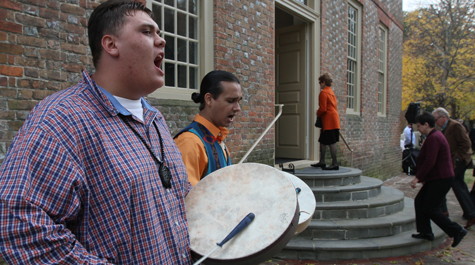New native studies minor program knits together natural connections
William & Mary William & Mary is a natural place for an undergraduate program devoted to the study of indigenous peoples and now the university has one.
A new minor in native studies officially began with the opening of the spring semester. It’s based in the Department of Anthropology, but is open to students in any major.
Creation of the new minor was the work of a number of William & Mary faculty and administrators, but the effort was spearheaded by Kathleen Bragdon, professor of anthropology, and Danielle Moretti-Langholtz, research assistant professor and director of the American Indian Resource Center. It’s early days, so they have no figures for enrollment in the new program, but the two scholars expect broad and deep interests.
“Because it’s such an interdisciplinary program, I could see students who are interested in American history generally being interested. Obviously, anthropology students would be interested from the point of view of regional ethnographic and archaeological research,” Bragdon explained. “But we also hope to attract people whose interest is more international, such as people who are interested in indigenous peoples throughout the world.”
As the new program is just getting underway, Bragdon explained that students enrolling in any of the classes within the new minor are automatically registered for credit in native studies.
Moretti-Langholtz said that the deep history of William & Mary with American Indians was one of the intellectual driving forces behind formation of the native studies minor. Along with Buck Woodard Ph.D. ’13, Moretti-Langholtz curated a recent exhibit at the Muscarelle Museum that recalled the 18th century school for native youth that occupied the building that now holds the offices of William & Mary’s president and provost.
Titled “Building the Brafferton: The Founding, Funding and Legacy of America’s Indian School,” the exhibit not only chronicled the years that William & Mary’s Indian students, but also addressed the university’s renewed connections with members of the American Indian community.
Moretti-Langholtz said she began thinking about a native studies program shortly after the establishment of the American Indian Resource Center in 1998.
“It was a place to support faculty, tribal outreach, civic engagement. But I found that I was getting calls from Indian communities who remembered that they had a history with William & Mary,” she said. “They would call to ask about the Brafferton: Did Indians still come back to the school? That really was the beginning of my thinking that maybe we should have a concentration in native studies.”
Moretti-Langholtz and Bragdon point out that all the curricular components of the program — the individual courses — had been in place for some time. There are a number of eligible courses in anthropology and more than a dozen in other departments, covering topics ranging from archaeology, linguistic studies, biological and cultural anthropology, material culture, museology and human biology.
“We found that there were many faculty who had been offering courses that had a native focus,” Moretti-Langholtz said. “So it wasn’t at all hard to bring these together into a nice curricular package.”
The two professors also say the new native studies program is a good fit for the new COLL curriculum, with the stress on interdisciplinary courses and opportunities for the COLL 300: In the World course, meant to encourage students’ cross-cultural awareness.
Moretti-Langholtz and Bragdon gave hat-tips to a number of people who helped make the native studies minor a reality, including Kate Conley, dean of Arts & Sciences, Dean of Graduate Studies Virginia Torczon, Professor of English Jack Martin, Margaret L. Hamilton Associate Professor of History Andy Fisher and Charles Center Director Joel Schwartz.















